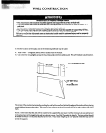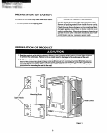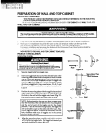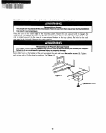
HOOD EXHAUST DUCT
When the hood is vented to the outside, a HOOD EXHAUST DUCT is required. All ductwork must be metal
(do not use plastic duct). Check that all connections are made securely. Please read the following carefully:
Fire Hazard
Mntirg system must terminate to the outside. Do Not terminate the ductwoh in an attic or other
enclosed space. Do Not use 4” laundrytyp wall caps.
To do any of the above may resutt in a fife.
EXHAUST CONNECTION: The hood exhaust has been designed to connect to a standard 3-l/4” x10”
rectangular duct.
If round duct is required, a rectangular-to-round adaptor must be used. do not use a duct that is
less than
6”
in diameter.
REAR EXHAUST: If a rear or horizontal exhaust is to be used, care should be taken to align the
exhaust with the space between the studs, or wall should be prepared at the time it is constructed by
leaving enough space between wall studs to accommodate exhaust.
MAXIMUM DUCT LENGTH: For satisfactory air movement, the total duct length of 3-1/4”xlO”
rectangular or 6” diameter round duct should not exceed 140 feet.
ELBOWS, ADAPTORS, WALL, ROOF CAPS, etc. present additional resistance to air flow and are equivalent
to a section of straight duct which is longer than their actual physical size. When calculating the total
length, add the equivalent lengths of all transitions and adaptors plus the length of all straight duct sections.
The diagram below shows the approximate feet of equivalent length of some typical ductwork parts. Use
the values in parentheses for calculating air flow resistance equivalent, which should total less than 140 feet.
EXHAUST DUCT
90°
ELBOW
(10 FT.1
(r WIDE ELBOW (10 FT.)
WALL CAP
(40 FT.1
ff2
45’
ELBOW (5 FT.)
90° ELBOW US FT.1
ROOF CAP
04 IT.)
ADAPTOR (5 FT.1
45.
ELBOW (5 FT.)
WALL AND ROOF CAPS USED MUST HAVE BACK-DRAFT DAMPER.
4


















